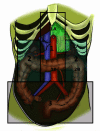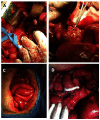Damage control in abdominal vascular trauma
- PMID: 35027780
- PMCID: PMC8754163
- DOI: 10.25100/cm.v52i2.4808
Damage control in abdominal vascular trauma
Abstract
In patients with abdominal trauma who require laparotomy, up to a quarter or a third will have a vascular injury. The venous structures mainly injured are the vena cava (29%) and the iliac veins (20%), and arterial vessels are the iliac arteries (16%) and the aorta (14%). The initial approach is performed following the ATLS principles. This manuscript aims to present the surgical approach to abdominal vascular trauma following damage control principles. The priority in a trauma laparotomy is bleeding control. Hemorrhages of intraperitoneal origin are controlled by applying pressure, clamping, packing, and retroperitoneal with selective pressure. After the temporary bleeding control is achieved, the compromised vascular structure must be identified, according to the location of the hematomas. The management of all lesions should be oriented towards the expeditious conclusion of the laparotomy, focusing efforts on the bleeding control and contamination, with a postponement of the definitive management. Their management of vascular injuries includes ligation, transient bypass, and packing of selected low-pressure vessels and bleeding surfaces. Subsequently, the unconventional closure of the abdominal cavity should be performed, preferably with negative pressure systems, to reoperate once the hemodynamic alterations and coagulopathy have been corrected to carry out the definitive management.
En pacientes con trauma de abdomen que requieren laparotomía, hasta una cuarta o tercera parte, habrán sufrido una lesión vascular. Las estructuras venosas principalmente lesionadas son la vena cava y las iliacas, y de vasos arteriales, son las iliacas y la aorta. El abordaje de este tipo de heridas vasculares se puede ser difícil en el contexto de un paciente hemodinámicamente inestable ya que requiera medidas rápidas que permita controlar la exanguinación del paciente. El objetivo de este manuscrito es presentar el abordaje del trauma vascular abdominal de acuerdo con la filosofía de cirugía de control de daños. La primera prioridad en una laparotomía por trauma es el control de la hemorragia. Las hemorragias de origen intraperitoneal se controlan con compresión, pinzamiento o empaquetamiento, y las retroperitoneales con compresión selectiva. Posterior al control transitorio de la hemorragia, se debe identificar la estructura vascular comprometida, de acuerdo con la localización de los hematomas. El manejo de las lesiones debe orientarse a la finalización expedita de la laparotomía, enfocado en el control de la hemorragia y contaminación, con aplazamiento del manejo definitivo. Lo pertinente al tratamiento de las lesiones vasculares incluyen la ligadura, derivación transitoria y el empaquetamiento de vasos seleccionados de baja presión y de superficies sangrantes. Posteriormente se debe realizar el cierre no convencional de la cavidad abdominal, preferiblemente con sistemas de presión negativa, para consecutivamente reoperar una vez corregidas las alteraciones hemodinámicas y la coagulopatía para realizar el manejo definitivo.
Keywords: Vascular system injuries; amputation; anastomosis, surgical; aorta, abdominal; compartment syndromes; dissection; femoral vein; hematoma; hemodynamics; ischemia; laparotomy; mesenteric artery, superior; mesenteric veins; peritoneal cavity; portal vein; renal veins; reperfusion; vena cava, inferior; viscera.
Copyright © 2021 Colombia Medica.
Conflict of interest statement
Conflict of Interest: The authors declare that they have no conflict of interest.
Figures


























References
-
- 1. Branco BC, Musonza T, Long MA, Chung J, Todd SR, Wall MJ, et al. Survival trends after inferior vena cava and aortic injuries in the United States. J Vasc Surg. 2018; 68(6):1880-1888. doi:10.1016/j.jvs.2018.04.033. - PubMed
- Branco BC, Musonza T, Long MA, Chung J, Todd SR, Wall MJ. Survival trends after inferior vena cava and aortic injuries in the United States. J Vasc Surg. 2018;68(6):1880–1888. doi: 10.1016/j.jvs.2018.04.033. - DOI - PubMed
-
- 2. De Bakey ME, Simeone FA. Battle Injuries of the Arteries in World War II : An Analysis of 2,471 Cases. Ann Surg. 1946; 123(4): 534-579 Doi: 10.1097/00000658-194604000-00005. - PMC - PubMed
- De Bakey ME, Simeone FA. Battle Injuries of the Arteries in World War II An Analysis of 2,471 Cases. Ann Surg. 1946;123(4):534–579. doi: 10.1097/00000658-194604000-00005. - DOI - PMC - PubMed
-
- 3. Rich NM, Baugh JH, Hughes CW. Acute arterial injuries in Vietnam: 1,000 cases. J Trauma. 1970; 10(5):359-369. Doi: 10.1097/00005373-197005000-00001. - PubMed
- Rich NM, Baugh JH, Hughes CW. Acute arterial injuries in Vietnam 1,000 cases. J Trauma. 1970;10(5):359–369. doi: 10.1097/00005373-197005000-00001. - DOI - PubMed
-
- 4. Patel JA, White JM, White PW, Rich NM, Rasmussen TE. A contemporary, 7-year analysis of vascular injury from the war in Afghanistan. J Vasc Surg. 2018; 68(6):1872-1879. Doi: 10.1016/j.jvs.2018.04.038. - PubMed
- Patel JA, White JM, White PW, Rich NM, Rasmussen TE. A contemporary, 7-year analysis of vascular injury from the war in Afghanistan. J Vasc Surg. 2018;68(6):1872–1879. doi: 10.1016/j.jvs.2018.04.038. - DOI - PubMed
-
- 5. Mattox KL, Feliciano DV, Burch J, Beall AC, Jr Jordan GL, Jr De Bakey ME. Five thousand seven hundred sixty cardiovascular injuries in 4459 patients. Epidemiologic evolution 1958 to 1987. Ann Surg. 1989; 209(6): 698-705. Doi: 10.1097/00000658-198906000-00007. - PMC - PubMed
- Mattox KL, Feliciano DV, Burch J, Beall AC, Jr Jordan GL. Jr De Bakey ME Five thousand seven hundred sixty cardiovascular injuries in 4459 patients Epidemiologic evolution 1958 to 1987. Ann Surg. 1989;209(6):698–705. doi: 10.1097/00000658-198906000-00007. - DOI - PMC - PubMed
Publication types
MeSH terms
LinkOut - more resources
Full Text Sources

